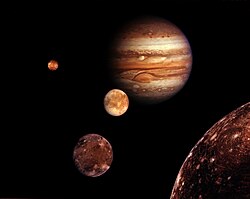 Cordelia (bottom), Ophelia (top), and Uranus's narrow rings photographed from afar by Voyager 2 on 21 January 1986 | |
| Discovery [1] | |
|---|---|
| Discovered by | Richard J. Terrile / Voyager 2 |
| Discovery date | January 20, 1986 |
| Designations | |
Designation | Uranus VI |
| Pronunciation | /kɔːrˈdiːliə/ [2] |
| Adjectives | Cordelian [3] |
| Orbital characteristics [4] | |
| 49751.722±0.149 km | |
| Eccentricity | 0.00026±0.000096 |
| 0.33503384±0.00000058 d | |
| Inclination | 0.08479°±0.031° (to Uranus's equator) |
| Satellite of | Uranus |
| Group | ring shepherd |
| Physical characteristics | |
| Dimensions | 50 × 36 × 36 km [5] [note 1] |
| ~5200 km2 [a] | |
| Volume | 33900±34.9% km3 [6] |
| Mass | (6.08±0.57)×1016 kg [6] |
Mean density | 1.79+0.97 −0.49 g/cm3 [6] |
| ~0.006–0.013 m/s2 [a] | |
| ~0.018–0.021 km/s [a] | |
| synchronous [5] | |
| zero [5] | |
| Albedo | 0.06±0.01 [7] 0.07 [8] |
| Temperature | ~65 K [a] |
| 23.62 (at opposition) | |
| |
Cordelia is the innermost known moon of Uranus. It was discovered from the images taken by Voyager 2 on January 20, 1986, and was given the temporary designation S/1986 U 7. [1] It was not detected again until the Hubble Space Telescope observed it in 1997. [7] [9] Cordelia takes its name from the youngest daughter of Lear in William Shakespeare's King Lear. It is also designated Uranus VI. [10]
Contents
Other than its orbit, [4] size of 50 km × 36 km (31 mi × 22 mi), [5] and geometric albedo of 0.06, [7] little is known about it. In the Voyager 2 images, Cordelia appears as an elongated object with its major axis pointing towards Uranus. The ratio of axes of Cordelia's prolate spheroid is 0.7±0.2. [5]
Cordelia acts as the inner shepherd satellite for Uranus's ε ring. [11] Cordelia's orbit is within Uranus's synchronous orbit radius, and is therefore slowly decaying due to tidal deceleration. [5]
Cordelia is very close to a 5:3 orbital resonance with Rosalind. [12]

